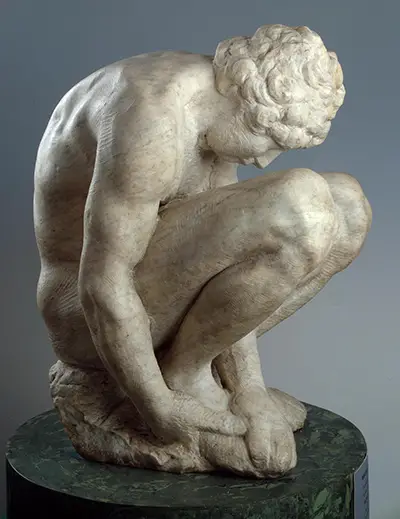Vasari, in his biography of Michelangelo, suggested that he represented the highpoint of artistic accomplishment since the Renaissance had begun. Vasari’s opinion has been confirmed, in the centuries after his death, by the fact that Michelangelo has been widely viewed as one of the most skilled and influential artists in the history of Western Art.
Today Crouching Boy is to be found in the Hermitage Museum in Saint Petersburg, the only work by Michelangelo in the Museum’s collection. It is a small, unfinished, piece, sculpted in marble, measuring only 22 ins. (54 cm.) and shows a boy, naked and crouching down, perhaps to tend his injured foot. The boy’s body is well developed, with prominent musculature, and his crouching figure strongly suggests the inner strength compressed within him.
The boy’s head is turned down as he concentrates on his foot, oblivious to all that is going on around him, and contributes to the sense of sorrow and pain that the piece evokes.
Yet the work remains enigmatic. Some scholars have seen the piece as a representation of the unborn soul, others as a wounded soldier. Still others interpret the “Crouching Boy” as the personification of Genius or of the suffering of mourning.
The Crouching Boy was brought to Russia by Catherine the Great (1729 - 1796) when she purchased a large collection of antiquities and other pieces from the English antiquary and banker, John Lyde Browne (died 1787).
Lyde-Browne was an enthusiastic collector of antiquities and had accumulated one of the largest collections of the time having visited Italy many times since the 1750s. His collection was in a constant state of flux as he was trading extensively in these objects, with other collectors, as well as collecting them. His house in London served as much as a showroom as it did a private museum.
Catherine the Great agreed to pay about £23,000 for around 250 of Lyde-Browne’s pieces in 1785, but he only received the initial £10,000 payment as a result of the bankruptcy of his agent in St Petersburg.
In addition to his collection of antique marble pieces, Lyde-Browne had gathered together a collection of Renaissance works. Among these was an item described in one of the catalogues of his collections as “an unfinished statue of a boy removing a thorn from his foot, a celebrated work by Michelangelo. The boy is naked and has superbly rendered anatomy. It is said that the statue was formerly in the Villa Medici”.
In 1520 Giulio de’ Medici commissioned Michelangelo to design a family vault, what was to become the Sagrestia Nuova, within the Medici’s parish church of San Lorenzo. Michelangelo’s drawings, now held in the British Museum, suggest that “Crouching Boy” was intended to be a part of his design for this Medici Chapel.
In his preparatory sketch of a double wall tomb for Lorenzo de’ Medici and his brother Giuliano de’ Medici, Michelangelo included two such crouching figures. It would have been appropriate for a work like the “Crouching Boy”, with its sense of hunched sorrow, to have had a place in such a scheme but the two crouching boys were not included in his final design for the project.
It was a project that Michelangelo would have had a personal interest in. It was Lorenzo de’ Medici that summoned Michelangelo to be a member of his household when he was still a teenager. As part of the Medici household he studied under the famous sculptor Bertoldo di Giovanni and was able to study the works of the Renaissance masters such as Giotto, Masaccio and Donatello and also those of the Greek and Roman sculptors that were available to him in the Medici collection.
It was also where Michelangelo met his future Papal patrons, Giovanni de’ Medici (Pope Leo X) and his cousin Giulio (Clement VII).
It was Michelangelo’s first project in which he designed both the architecture of the chapel, the sculptures and sarcophagi to be installed in the chapel including figures representing the four times of the day.
While the building itself was completed by 1524 the project suffered a number of interruptions, such as the period of exile of the Medici in 1527, the death of Giulio de’ Medici (Clement VII) and Michelango’s permanent relocation to Rome in 1534.
By this time most of the statues had been carved but they were not installed until 1545 in Michelangelo’s absence. The work was finally completed, again without Michelangelo’s presence, in 1555.


